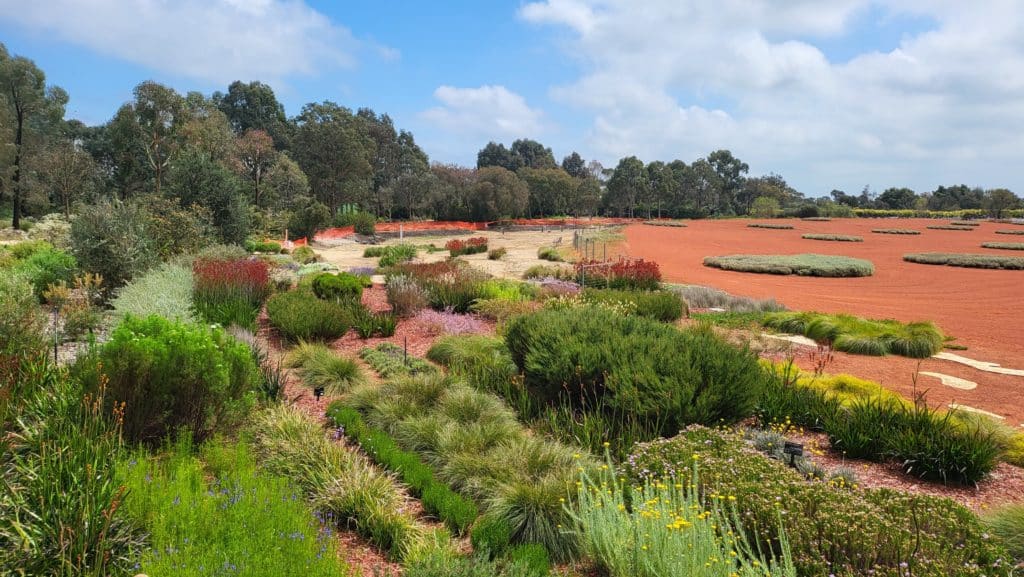One of Secret Design Studio’s current clients in Beaumaris is looking to re-imagine the front of their property between their mid-century home and the front boundary. Their Australian native garden was established when the house was first built, probably in the late 1960s or early 1970s. Their home is part of Bayside Council’s Vegetation Protection Overlay which has constraints on the removal of native vegetation and requires any new plantings to be similar natives to maintain the existing character of the area.
Like many Australian native gardens established in the 1960s, some of the trees are reaching the end of their natural life cycle. It is quite common for native plants that were established in the 1960s to have grown too big for the garden area available, and sometimes not be well maintained or pruned, especially when the previous owners were elderly. This can be one reason why some people don’t like Australian native gardens, as it makes them think of old, straggly and poorly maintained trees. It is time to challenge that perception.
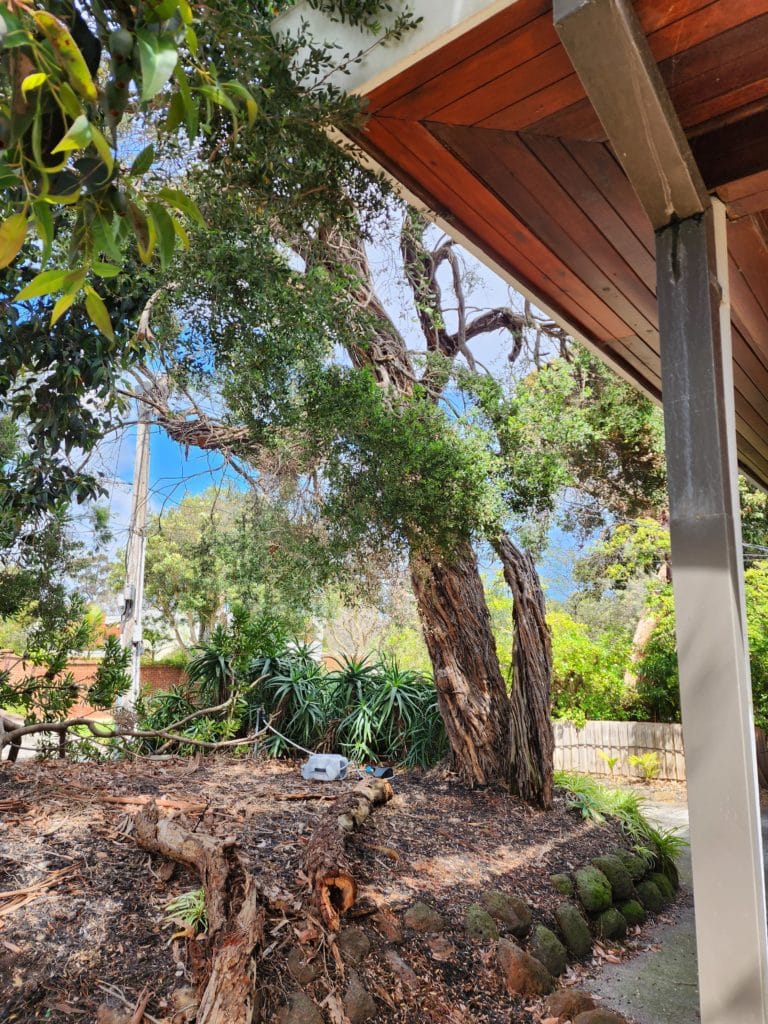
Like many Australian native gardens established in the 1960s, some of the trees are reaching the end of their natural life cycle. It is quite common for native plants that were established in the 1960s to have grown too big for the garden area available, and sometimes not be well maintained or pruned, especially when the previous owners were elderly.
But back to our Beaumaris garden. According to the report conducted by a qualified arborist, some of the trees are recommended for removal due to their ill-health and risk of falling in the next big storm. Whenever the health or longevity of trees is in question, Secret Design Studio always recommends the engagement of a qualified arborist to do a proper assessment and report.
Secret Design Studio’s go-to reference when hoping to inspire clients about Australian native gardens is the 1973 publication Reader’s Digest Practical Guide to Home Landscaping. However while this is an excellent resource showing many new Australian homes of the 1960s and 1970s with their newly established gardens, it is limited by the number of black and white photos. It also misses out on some of the exciting developments with new cultivars that have become available over the last 50 years.
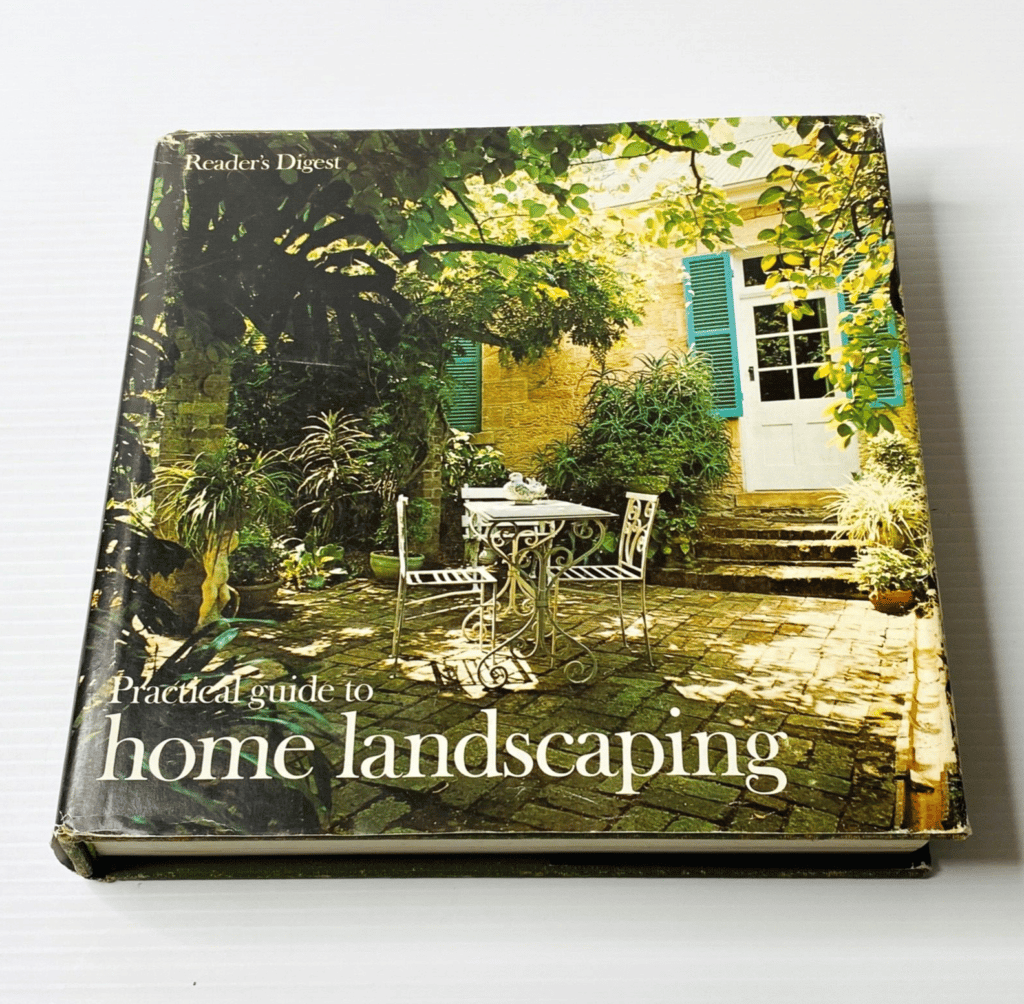
Secret Design Studio’s go-to reference when hoping to inspire clients about Australian native gardens is the 1973 publication Reader’s Digest Practical Guide to Home Landscaping.
The best inspiration Secret Design Studio can recommend for anybody considering an Australian native garden is a visit to Cranbourne’s Royal Botanic Gardens. Located around 45 km from the Melbourne CBD (or 35 km from Beaumaris) these gardens are a wonderful resource for the would-be or keen gardener alike. They are also a must-see visit for any international visitors who have a green thumb. Springtime is the perfect time to visit as there are so many flowers in bloom. If you are more interested in a day out where you don’t need to take your notebook, on a recent visit Secret Design Studio saw more than one birthday party in full swing.
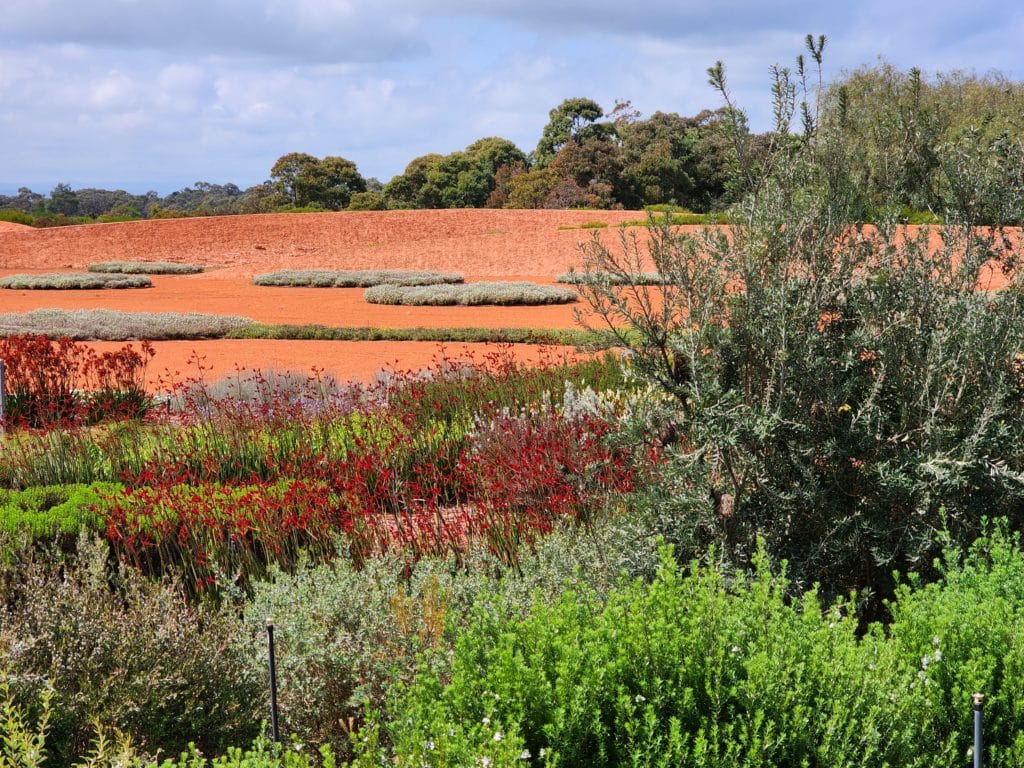
The Gardens themselves are divided into various precincts, with the visitor’s first sighting once you leave the Visitor’s Centre, the spectacular Red Sand Garden. This garden, with saltbush dotting the red sand, symbolises the red desert centre of Australia, with a noticeable absence of water.
These Gardens were opened to the public in 1989 and have come a very long way since their inception. The Australian Garden opened in 2006, with a second stage opening in 2011. You could be forgiven for thinking that walking the area would be an easy canter, as the Australian Garden (at 15 hectares) only occupies a portion of the entire site (some 363 hectares). But be warned – it is deceptively large, and you should allow at least two hours if you would like to cover the area at some leisure. Alternatively, you could join a guided walk, or take the Explorer bus (available for a small fee). According to the Royal Botanic Gardens website, the Gardens feature over 100,000 plants from 1900 plant species. The nearby bushland contains 450 indigenous plant species, as well as plenty of walking trails, lookouts, barbeque areas and playgrounds.
Link to Cranbourne Royal Botanic Gardens website
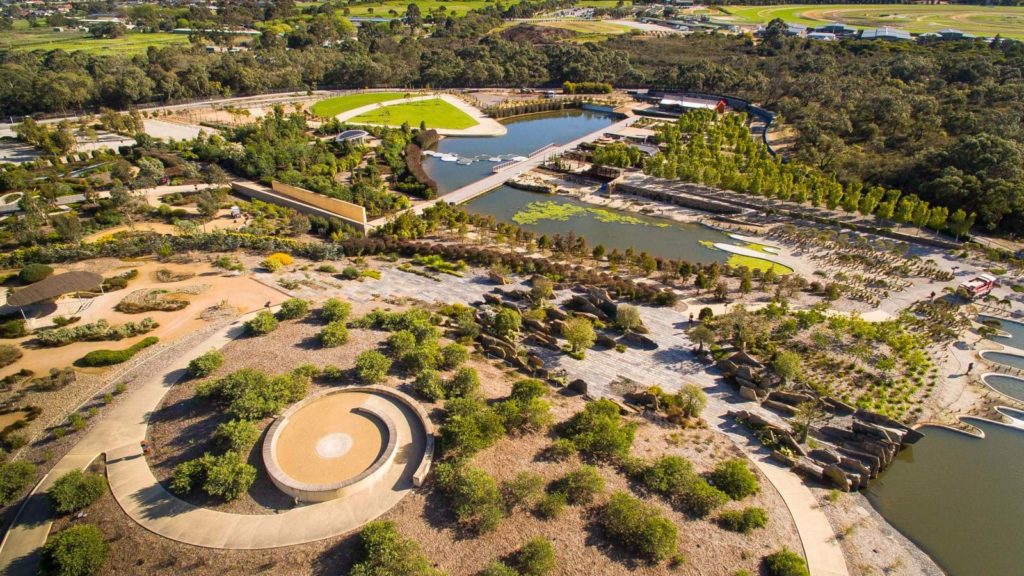
According to the Royal Botanic Gardens website, the Gardens feature over 100,000 plants from 1900 plant species.

According to the Royal Botanic Gardens website, the Gardens feature over 100,000 plants from 1900 plant species.
The Gardens themselves are divided into various precincts, with the visitor’s first sighting once you leave the Visitor’s Centre, the spectacular Red Sand Garden. This garden, with saltbush dotting the red sand, symbolises the red desert centre of Australia, with a noticeable absence of water.
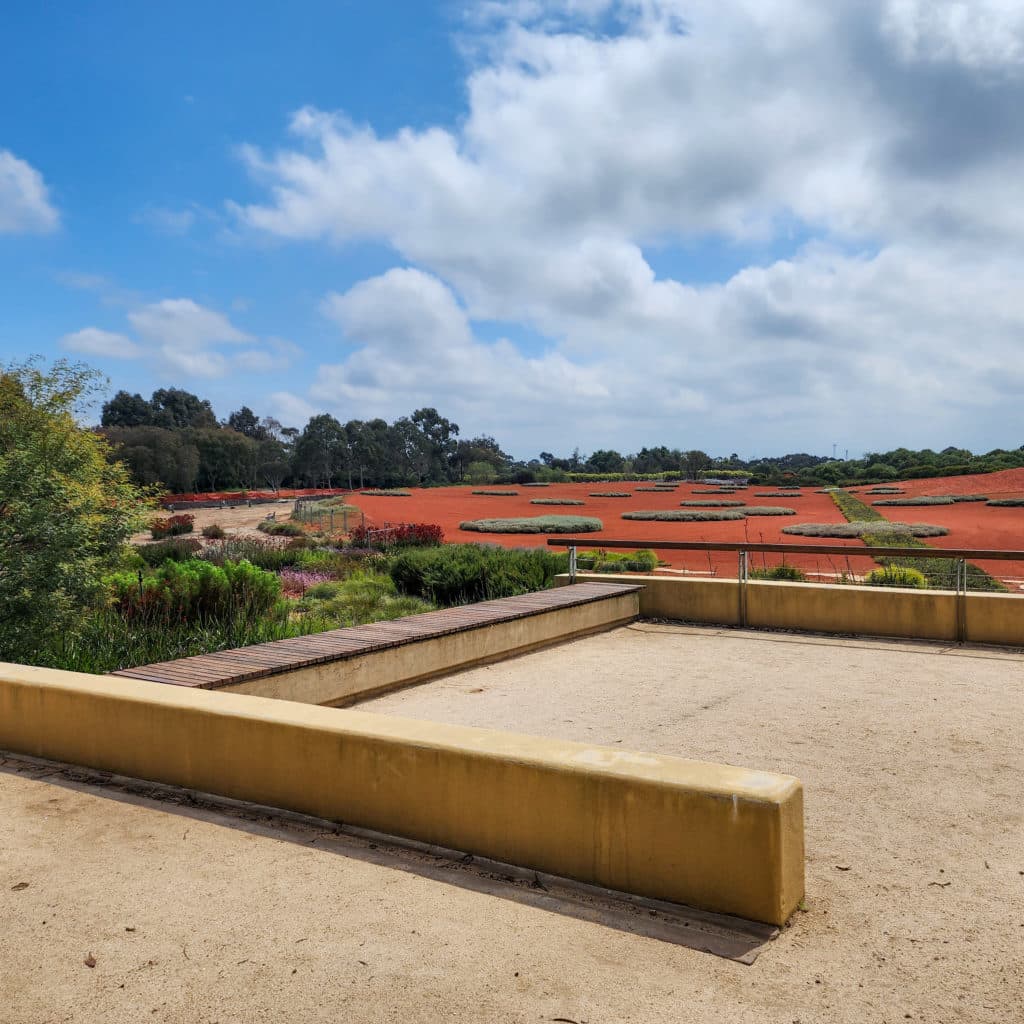
The Gardens themselves are divided into various precincts, with the visitor’s first sighting once you leave the Visitor’s Centre, the spectacular Red Sand Garden. This garden, with saltbush dotting the red sand, symbolises the red desert centre of Australia, with a noticeable absence of water.
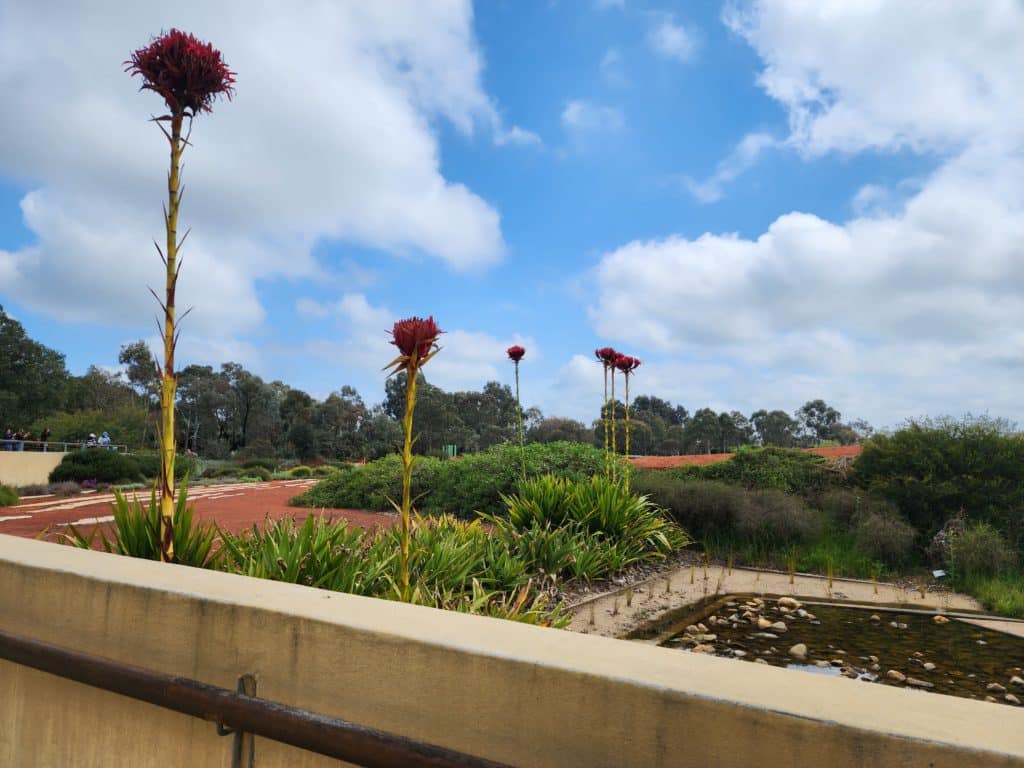
Some spectacular Gymea lilies at the start of a man-made water course adjacent to the “red centre”.
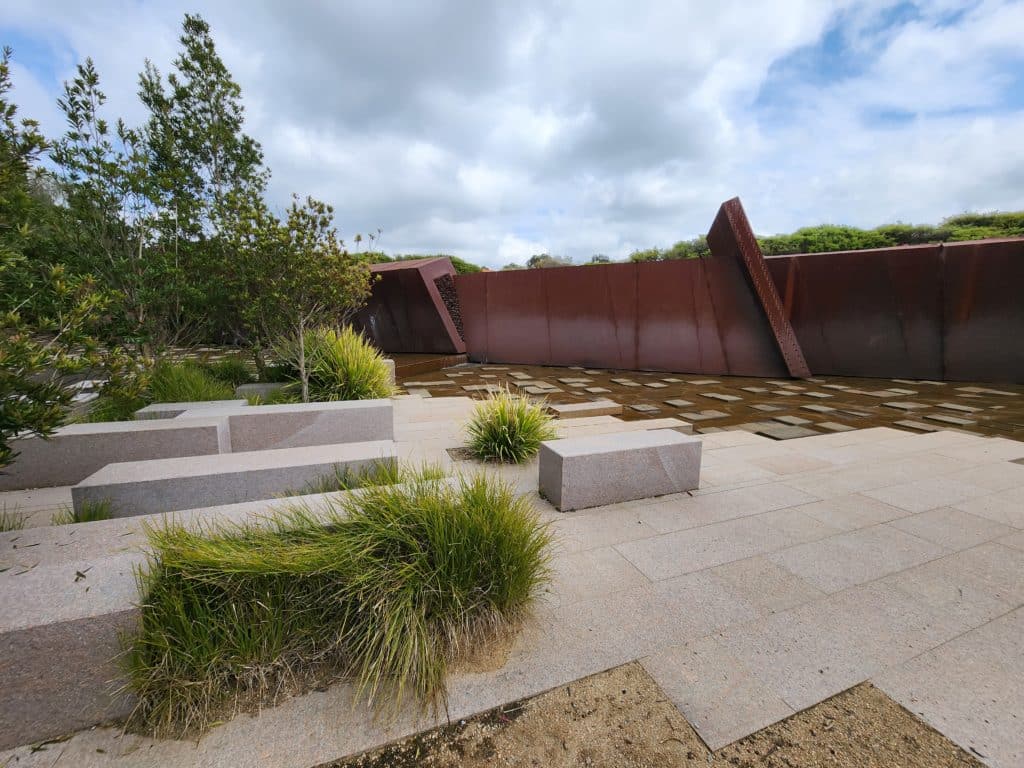
Continuation of the same man-made water course with stepping stones
Moving past the Red Sand Garden you will find various gardens across the Site, each one with possibilities to explore. They include exhibition gardens showing how Australian natives can be planted in your garden, such as the Water Saving Garden, showcasing plants with little or moderate watering requirements; the Home Garden, showing different plantings popular from the 1950s through to the 1970s; and the Research Garden, where endangered species are being grown in an effort to secure them for the future. The Seaside Garden could hold many ideas for bayside homeowners, while the Arbor Garden showcases many plants that happily grow in vertical environments.
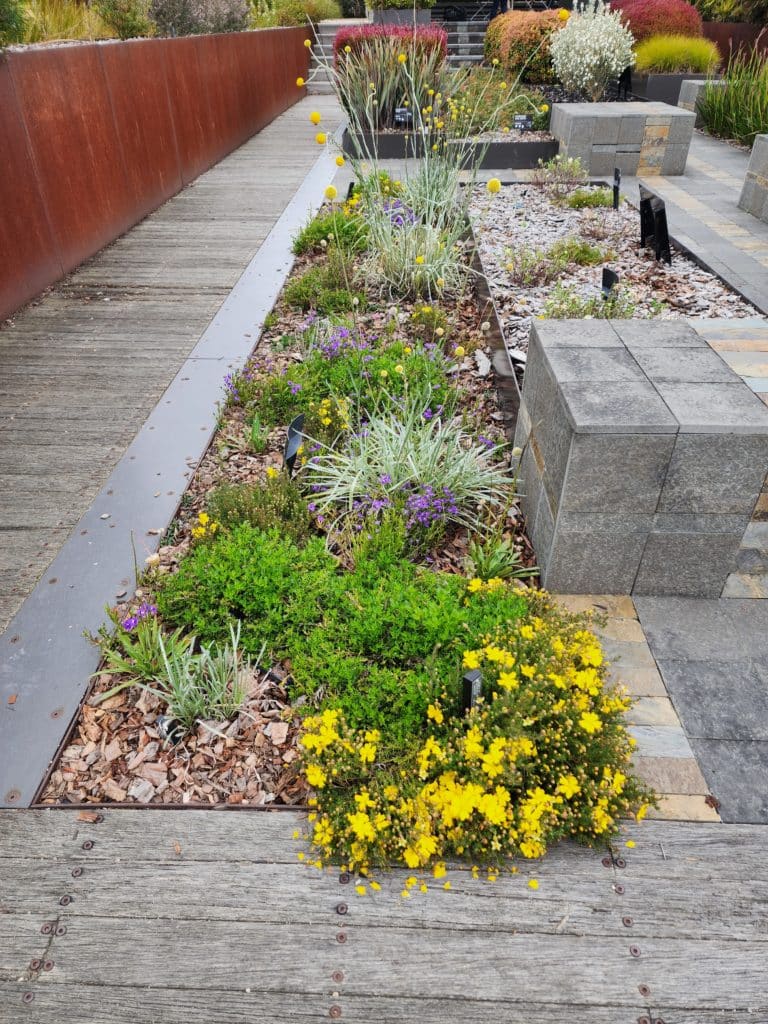
Spring is a great time to visit the Cranbourne Royal Botanic Gardens – not too hot, not too cold and a gloriously vibrant collection of flowering Australian native plants of every shape and size.
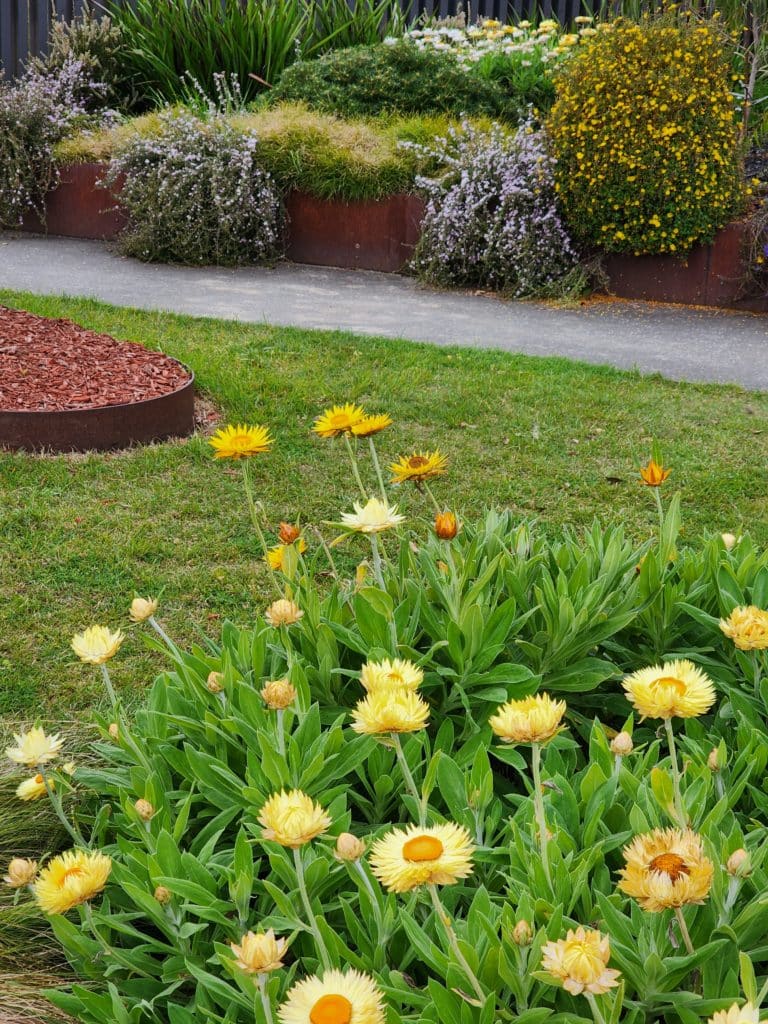
Spring is a great time to visit the Cranbourne Royal Botanic Gardens – not too hot, not too cold and a gloriously vibrant collection of flowering Australian native plants of every shape and size.
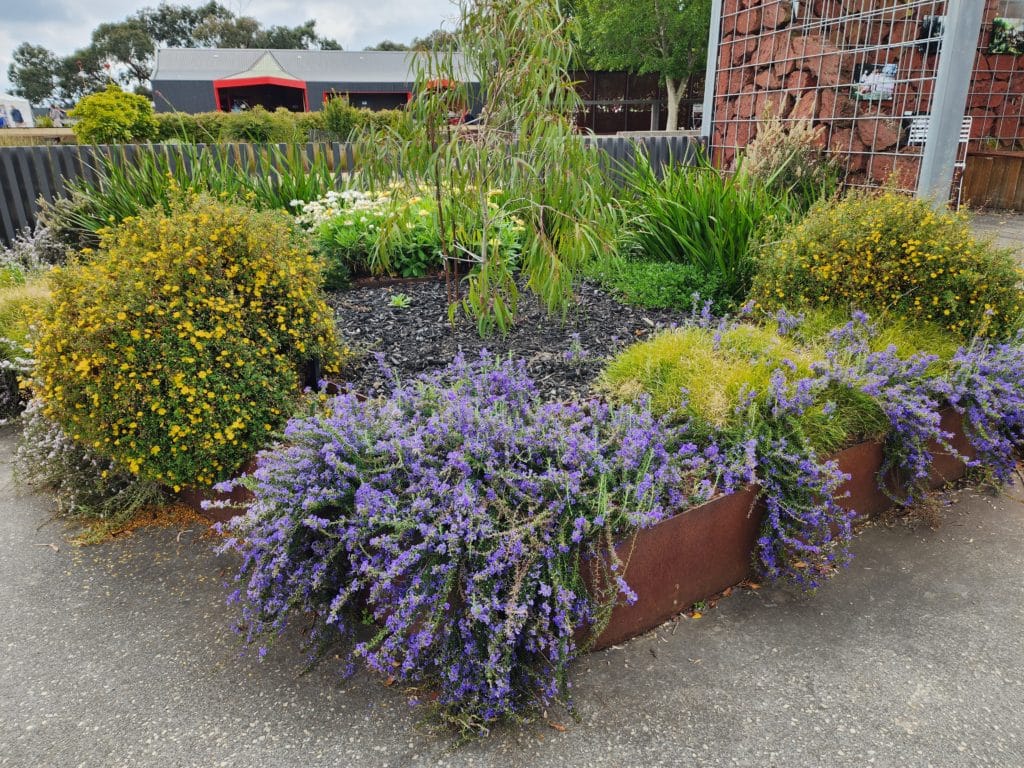
Spring is a great time to visit the Cranbourne Royal Botanic Gardens – not too hot, not too cold and a gloriously vibrant collection of flowering Australian native plants of every shape and size.
However it is not just the planting that is interesting, but the landscape infrastructure with so many different styles of paths, retaining walls, water features and bridges which are designed to complement each setting. One striking example is the Lily Pad bridge (with thanks to Geoff and Judy Steinicke and their family for their contributions to this charming and whimsical structure). This steel structure is cleverly designed to look and feel like it is delicately floating on the surface of the water, almost inviting you to tiptoe across.
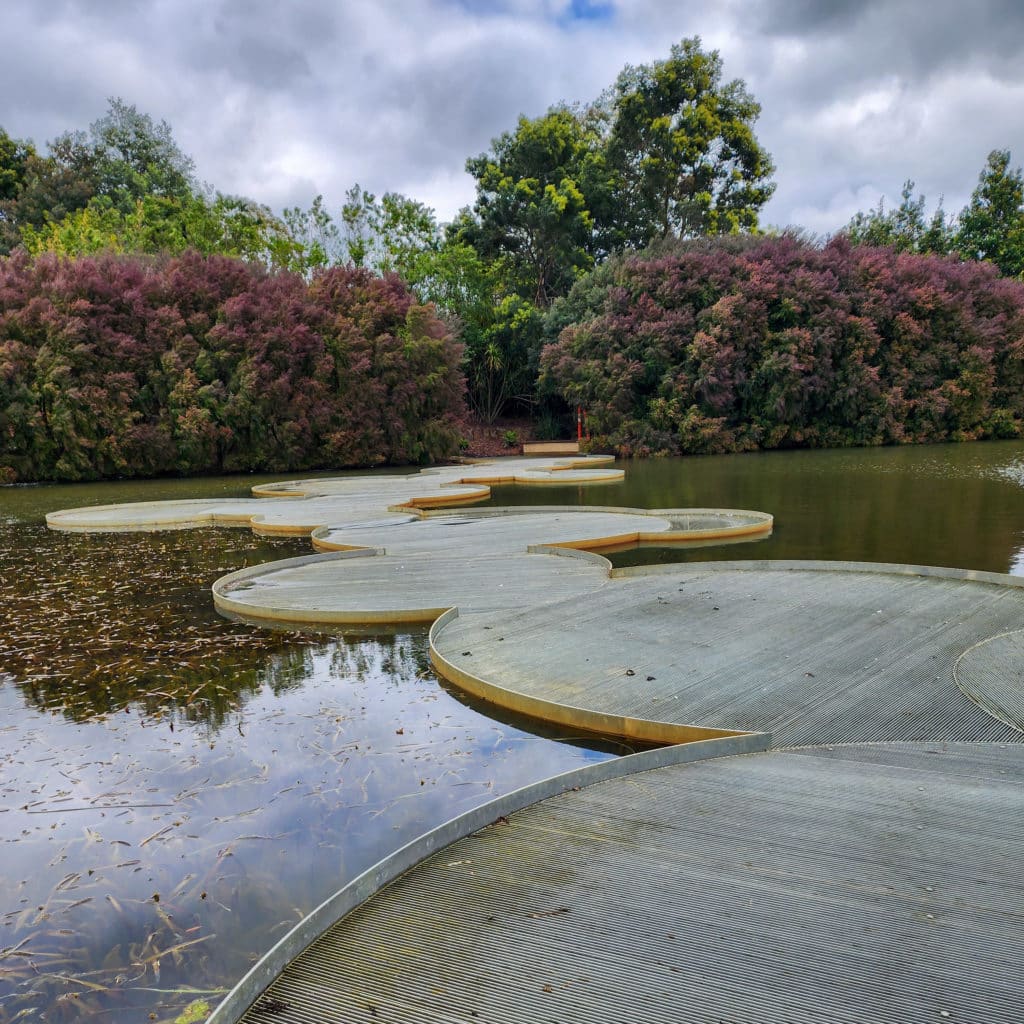
Cranbourne Royal Botanic Garden’s Lily Pad bridge (with thanks to Geoff and Judy Steinicke and family for their contributions to this charming and whimsical structure). This steel structure is cleverly designed to look and feel like it is delicately floating on the surface of the water, almost inviting you to tiptoe across.
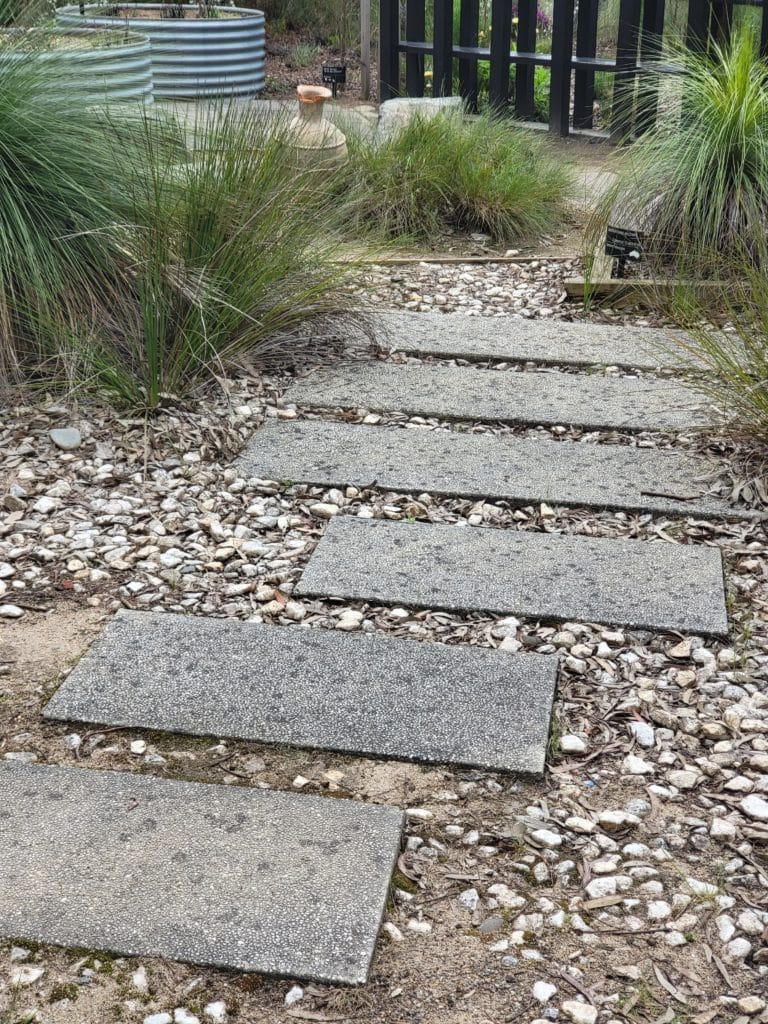
A variety of paving types suitable for mid-century residential garden design are spread around the Cranbourne Royal Botanic Gardens
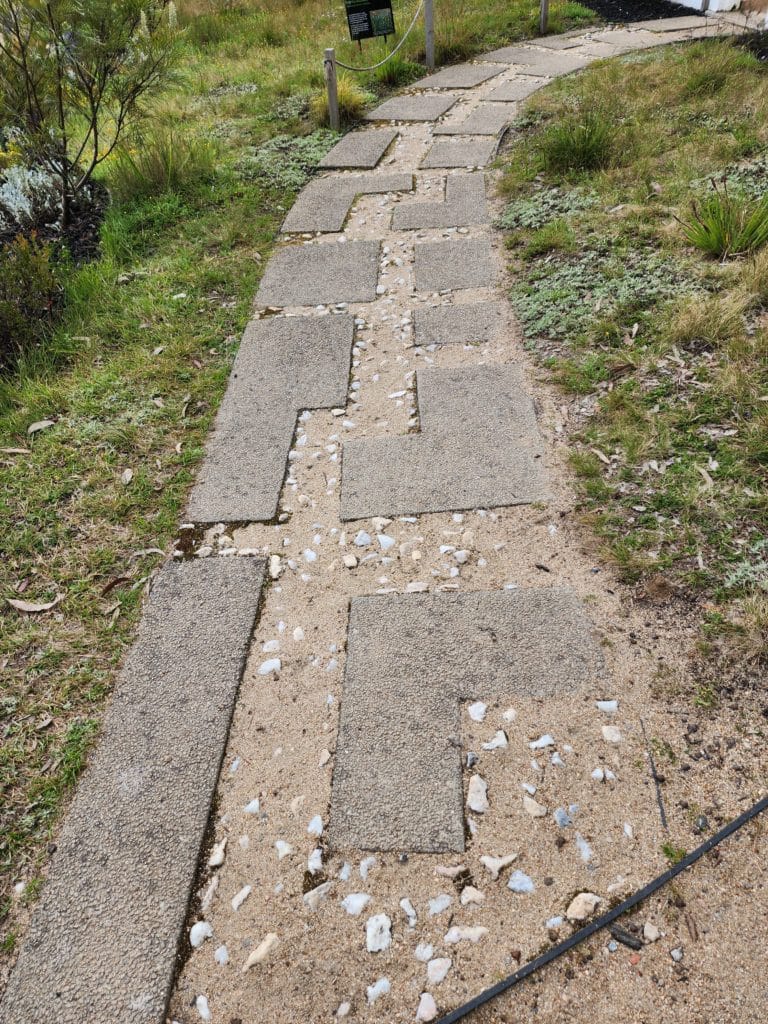
A variety of paving types suitable for mid-century residential garden design are spread around the Cranbourne Royal Botanic Gardens
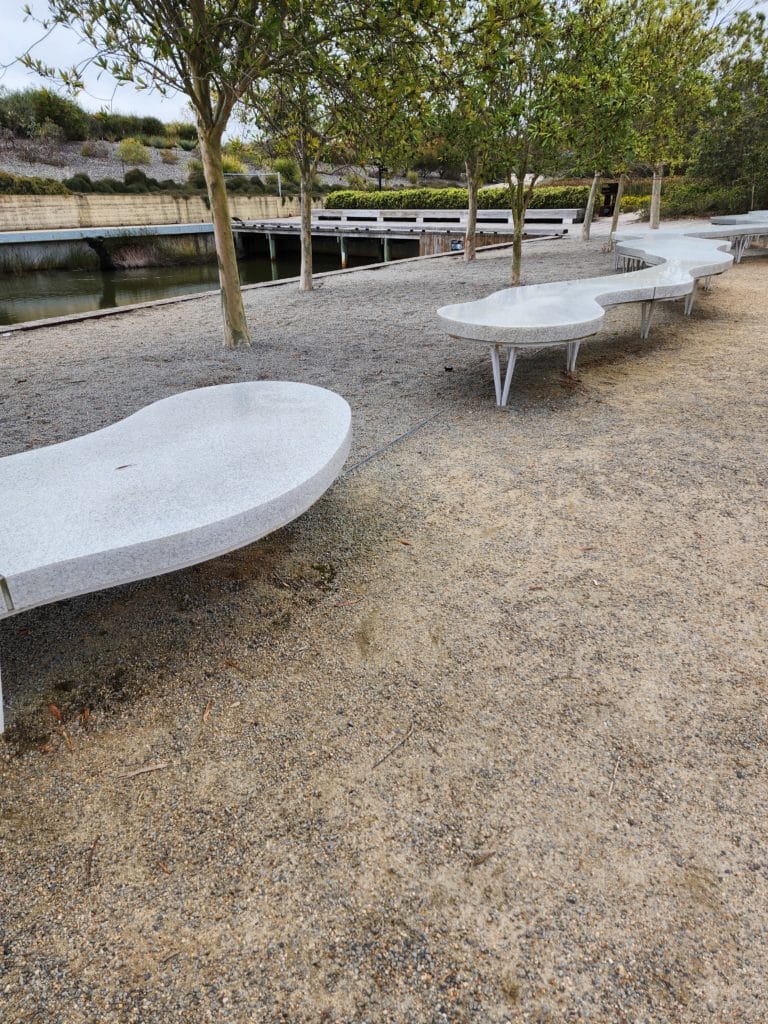
“Floating” cloud-shaped seating from granite and steel with a mid-century vibe at the Cranbourne Royal Botanic Gardens
The Eucalypt Walk pays homage to this beautiful tree, including the Stringybark, Peppermint and Ironbark gardens. There is something special about a eucalypt, with so many different types of bark, growth habit and scent. More than any other part of the Gardens, this is the place to shut your eyes and take deep breaths, and allow yourself to be carried off. Eucalypts come in many shapes and sizes – around 700 species – so there is plenty of scope to find a hero tree or two for your home.

There is something special about a eucalypt, with so many different types of bark, growth habit and scent.
The Gardens provide ideas not just about species of plants, but how they might be planted, and what they look like in different hard landscaping treatments. Seating is plentiful but unobtrusive, and small areas are designed to accommodate various garden rooms. Different treatments are used for pathways. You can forget any of your preconceptions of what a Botanic Garden should look like – the Cranbourne Botanic Gardens work so well as there is such a large variety of outdoor spaces, from intimate, residential-scale courtyards to sweeping vistas, and everything in-between.
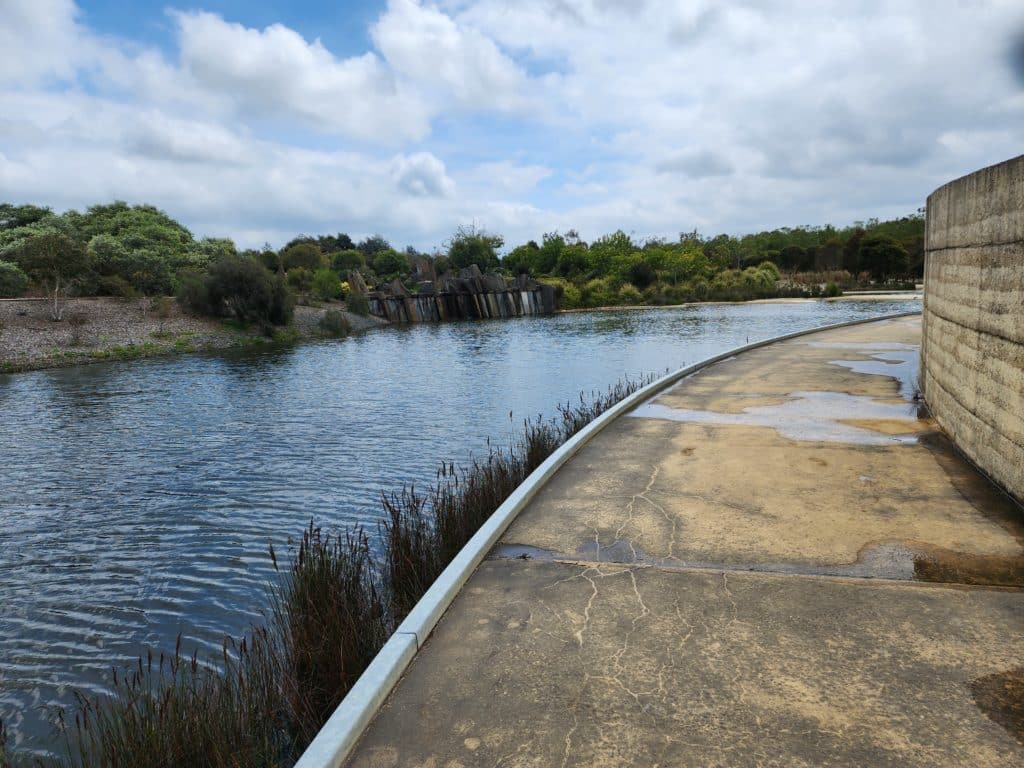
You can forget any of your preconceptions of what a Botanic Garden should look like – the Cranbourne Roayal Botanic Gardens work so well as there is such a large variety of outdoor spaces, from intimate, residential-scale courtyards to sweeping vistas, and everything in-between.
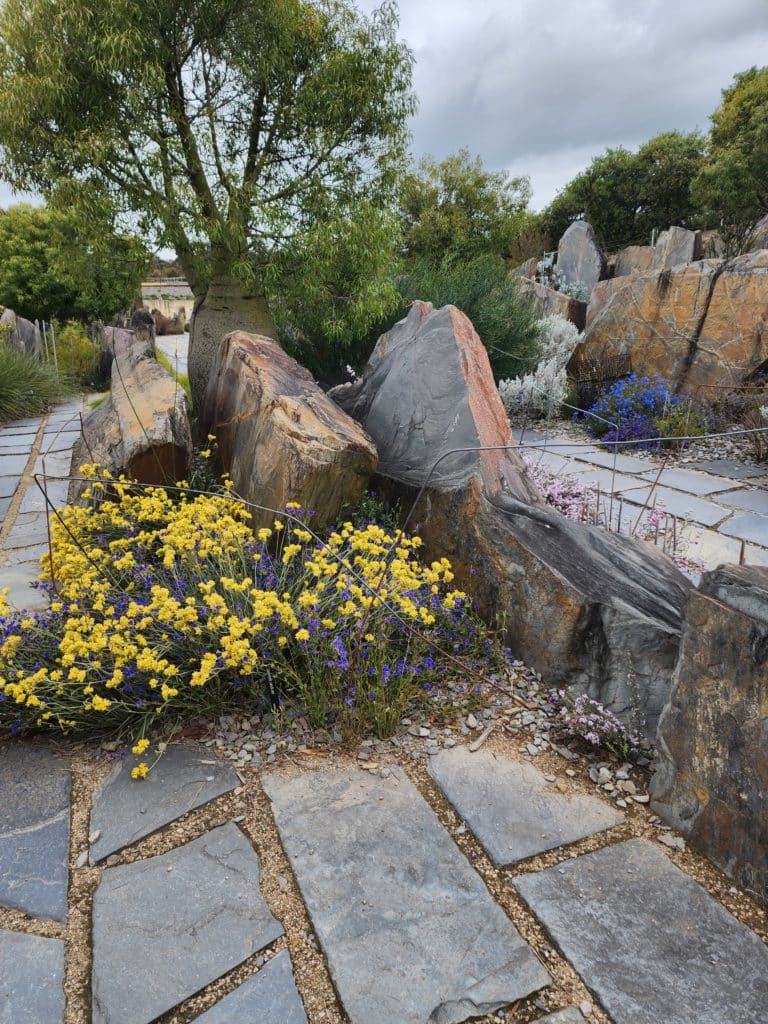
You can forget any of your preconceptions of what a Botanic Garden should look like – the Cranbourne Roayal Botanic Gardens work so well as there is such a large variety of outdoor spaces, from intimate, residential-scale courtyards to sweeping vistas, and everything in-between.
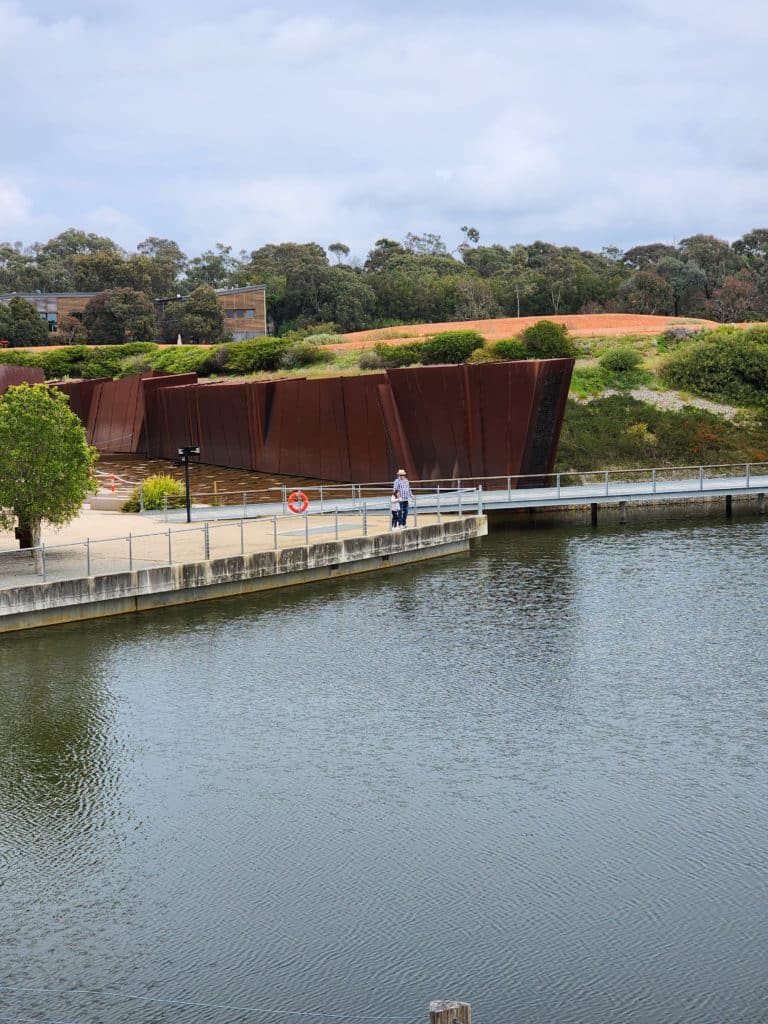
You can forget any of your preconceptions of what a Botanic Garden should look like – the Cranbourne Roayal Botanic Gardens work so well as there is such a large variety of outdoor spaces, from intimate, residential-scale courtyards to sweeping vistas, and everything in-between.
So a native garden can add character and value to your MCM home, as well as provide shelter for local bird and other wildlife, adding to your area’s biodiversity. Now is the perfect time to reimagine your garden, and embrace the beauty and diversity of a native garden. If you live in Melbourne or its surrounds, a living laboratory is just down the road. If you live interstate or are visiting from overseas, the Royal Botanic Gardens at Cranbourne should definitely be added to your must-see list.



